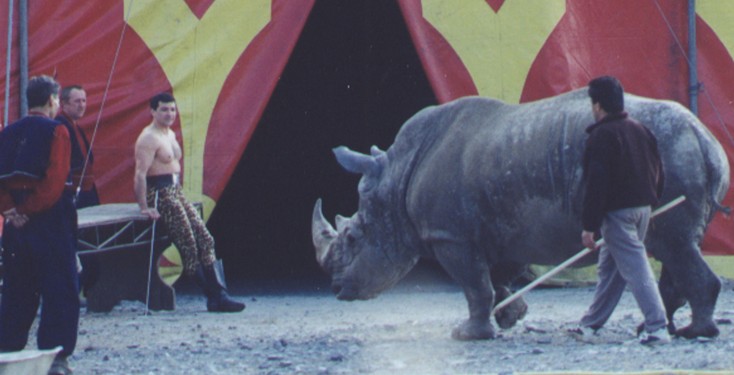New campaign to end use of animals in circuses in Ireland
ADI investigations reveal extent of suffering for the first time

A new hard-hitting campaign to stop the use of animals in circuses is being launched in Ireland today by Animal Defenders International (ADI) and Animal Rights Action Network (ARAN). The campaign report on Ireland’s circuses is based on undercover investigations by ADI Field Officers into seven circuses touring Ireland in 2000 and 2003. ADI Field Officers obtained employment with two Irish circuses, and observed many more.
This is the fifth ADI ‘Stop Circus Suffering’ campaign following launches in UK, Chile, Norway and Portugal, and reveals that around 150 animals are touring Ireland with travelling circuses. These animals endure severe confinement in deprived and unnatural environments, inadequate diets and physical abuse.
Tim Phillips, campaigns director for ADI, announced: “ADI and ARAN hope that this will be the biggest ever push to end the use of animals in circuses in Ireland and we will be distributing DVDs, leaflets and a report that features the extent of circus suffering in Ireland for the first time.”
Examples of the violence used to control the animals were captured in the Irish launch video:
a camel slapped in the face and then hit in the face with a broom and finally jabbed with a broom handle
an elephant kicked in the leg and then punched in the face
a hippo whipped to hurry it along when it was already walking in the desired direction
a keeper whipping an elephant in order to get her to move
a baby camel being roughly handled to force him to move
a pregnant camel performing just days before giving birth.
John Carmody, campaigns coordinator for Irish group, ARAN, said: “This investigation has revealed animal suffering in Irish circuses on a large scale, which the circus industry has been desperate to hide. If children only knew how these poor animals are treated, they would be totally shocked. Local councils need to know this and we will be lobbying them to ban the use of animal act circuses.”
The long haul
When the Irish circuses moved town, the report reveals, animals were kept in their trailers for unnecessarily long periods – up to almost 10 times longer than a journey had actually taken. When Italy’s Il Florilegio Circus (Darix Togni) toured Ireland, elephants were kept in their transporter during one journey for 59 hours.
At Courtney’s Mexican Circus, animals were observed left in their transporters for up to 43 hours without free access to water, and with no exercise. This was also true for the six tigers with Tom Duffy’s Circus, whose cramped enclosure was just 3.7 metres by 7.3 metres.
Micki, the elephant with Fossetts Circus (who the circus boasts is the largest African elephant in Europe), was filmed and photographed in a tent chained by both front and hind leg and barely able to move.
Public safety
Poor standards of public safety (and indeed animal safety) were evident especially when a hippo at the Il Florilegio Circus (Darix Togni) started to wander towards a main road because an electric fence had not been erected. Luckily an ADI Field Officer alerted staff before the animal reached the road. In the past 20 months, Ireland’s media have highlighted several instances of animals getting loose or attacking people. The new report is also critical of circuses that allow people to come into close contact with potentially dangerous wild animals like elephants. Circus Vegas, The American 3-Ring Circus and Daredevil Circus all used their elephants during the show interval for photographs with the audience and Daredevil allowed very small children to sit on the Asian elephants.
Confined to quarters
The ADI / ARAN report and video highlight how the needs of animals cannot be met when travelling from one temporary encampment to another, and setting up on what limited space is available. The campaigners found a wide range of animals including horses, ponies, elephants, a rhino, a hippo, camels, and tigers living in confined and deprived environments, in small cages or tethered on short ropes. Some animals did not even have free access to water. For example, during observations of Circus Vegas in Galway, a donkey and a pony spent the day tied at the edge of the circus grounds without any shelter or water.
Disturbed, repetitive behaviour
Living in such bleak, unnatural conditions, it is little wonder that many of these animals go out of their minds. Frustrated, repetitive, stereotypic behaviour takes over. These pointless movements, with the animal no longer aware of its surroundings, are not witnessed in the wild, and are regarded by animal behaviourists as clear signs of distress. We call it ‘circus madness’.
During this study, a number of animals were seen exhibiting disturbed behaviour. At Daredevil circus, elephants exhibited head bobbing and weaving stereotypic behaviour, a classic sign of circus animal stress – it was here that a presenter was caught on film kicking and punching one of the elephants. In Fossetts Circus, the solitary elephant performed stereotypic head weaving and bobbing for a significant part of the day. At Circus Vegas, the three African elephants were observed weaving whilst chained in tents. In Il Florilegio Circus (Darix Togni), all three elephants spent a significant amount of time exhibiting stereotypic behaviour, swaying from side to side and head bobbing. Disturbed behaviour was even filmed in camels and horses.
DVDs, leaflets, posters and reports available
Over the next few weeks and months, ARAN and ADI will be distributing campaign materials throughout Ireland. The groups are calling for local and national government action as well as Europe-wide action. All of Ireland’s MPs and MEPs will be sent the ‘Stop Circus Suffering’ DVD.
